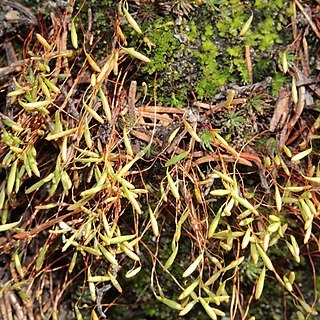Plants small to medium-sized, loosely caespitose to gregarious, green to yellow-green; terricolous. Stems 5-10(-20) mm long, reddish to reddish yellow, generally simple, sparsely tomentose below. Leaves longer and narrower above, forming comose tuft, appressed dry, erect-spreading wet; ovate-lanceolate, 1-2 mm long, becoming linear-lanceolate, 1.7-3.5 mm long at apex, forming distinct tuft; apex acuminate; margins generally plane but reflexed medially in upper leaves, entire below, generally denticulate at apex. Costa subpercurrent to percurrent; in section rounded, bulging dorsally, guide cells 2-4, occasionally with 1-2 ventral stereid cells, ventral surface cells large and weakly thickened but smaller than guide cells, dorsal stereid band 3-4 cells thick, frequently with hydroids below central guide cells, dorsal surface cells similar to ventral surface cells but more strongly thickened. Upper lamina cells mostly 4-10: 1, oblong-rhomboidal to linear, 37-100(-175) x 8-12 µm, weakly vermicular; basal cells weakly differentiated, linear to long-rectangular at insertion, walls straight. Autoicous. Perichaetia terminal, leaves ovate-acuminate, to 2 mm long. Seta erect, 10-30 mm long, yellow-brown; capsule generally ± asymmetrical, curved, inclined to horizontal, cylindrical-pyriform, 4-5 mm long, smooth, yellow-brown, neck ± distinct, mostly as long as urn; exothecial cells elongate-rhomboidal, weakly thickened, 2-3 rows at capsule mouth smaller, quadrate; stomata present on neck, phaneropore; annulus differentiated; peristome double, yellowish, exostome teeth narrowly triangular, finely papillose, endostome with low basal membrane, to one fifth height of teeth, segments broad, as high as teeth, cilia rudimentary to absent; operculum conic-apiculate; spores rounded, 18-25 µm, weakly papillose, light brown.
More
Plants small, green, dull. Stems0.5-2.5 cm. Leaves erect to ± spreading, lanceolate to ovate-lanceolate, 2 mm; margins subentire or more often serrulate to serrate in distal 1/3; costa subpercurrent or percurrent; distal medial laminal cells hexagonal to rhomboidal, , 45-85 µm, walls moderately thick. Specialized asexual reproduction absent. Sexual condition paroicous, autoicous, or rarely dioicous; perigonial leaves in dioicous plants broadly short-ovate; perichaetial leaves somewhat differentiated, ± long-lanceolate. Seta orange to orange-brown. Capsule inclined 10-90°, stramineous, orange, or orange-brown, short-to long-and slender-pyriform, neck 1/2-1 time urn length; exothecial cells elongate-rectangular, walls straight; stomata superficial; annulus present; operculum conic; exostome teeth yellow to brown, acute-triangular; endostome hyaline, basal membrane barely exceeding capsule rim or to 1/3 exostome length, segments narrowly or not keeled, narrowly to not perforate, cilia absent to rudimentary, rarely long. Spores 16-23 µm, distinctly roughened.
Plants loosely caespitose. Stems 5-20 mm long. Leaves longer and narrower above, appressed when dry, ovate-lanceolate, 1-2 mm long, becoming linear-lanceolate, 1.7-3.5 mm long at apex, forming distinct tuft; apex acuminate; margins entire to denticulate at apex; costa subpercurrent. Upper laminal cells oblong-rhomboidal to linear. Capsule curved, asymmetrical, inclined to horizontal, cylindrical-pyriform, neck as long as urn; peristome with exostome teeth and endostome segments, cilia present, rudimentary or absent.

